"NO SPAIN…NO GAIN"
Spain is the only "proper" European country that has eluded me, well if you exclude tiny semi-colons like Andorra and Lichtenstein, and I was determined to make amends. I had flown over Spain, had dinner with all her neighbours, knew a few Spanish words, ate tapas, drunk Spanish wine, and even sailed the Spanish Main. No, the closest that I ever got to Spain was when a university chum offered me some Spanish Fly, which was supposed to drive the women wild, but I declined and furtively hoped that 'rudimentary charm' might have the same effect! So when I saw the distant Pyrenees and started to recite Hillaire Belloc, and tell my wife about "The fleas that tease on the high Pyrenees", I am sure that she at least felt my excitement. "Are we in Spain yet?" I kept asking, rhetorically I thought, almost as soon as we left the railway station in Perpignan. She, however, took it to be a direct question and sighed 'that' sigh, which I know only too well. "Just wait till the flags change from the Tricoleur to red and yellow – then we will be in Spain" she said, and she looked at her watch, as she does when I am buying socks, or we are at the cricket. I did not have the heart, or the temerity, to tell her that in this part of Languedoc- Rossillon, the local flag was red and yellow as well, from that time not so long ago, when the Kings of Aragon controlled these parts. I just continued to look out the window at what I was sure was 'Spanish-style' housing, Spanish olive groves, Spanish orchards and Spanish vineyards, but I did so in silence. It would not be long, I thought, till I could say "Au revoir" to 'Allo', and hello to 'Ola'!
The Europe without 'internal borders' is an entity that we have got used to. There are empty border posts, or when they are manned, you are waved through by bored looking guards when they see yet another white face. But not at the French-Spanish border on the Mediterranean! In Cerbere, the edge of the diving board before you plunge into Spain, our train stopped and into our carriage stepped some very burly policemen, and secured each end of the carriage. "Allo allo" I thought, as a bullet-headed, gimlet-eyed Froggie version of Mike Tyson, looking straight out of the French Foreign Legion, came slowly down the carriage. "Bonjour" I ventured, "Passport" he responded, with all the growl of a Mack truck going up a steep hill, and he folded back my document to look for inserted pages and scrabbled at the photograph to see whether it was really sealed. Then he jabbed my document back to me and passed on. Soon a small, unhappy group of swarthy men were gathered on the platform and guarded by police colleagues. Then, after an eternity, the train moved slowly forward and into a tunnel, and when we emerged in Port Bou, a ruined castle above a tumbling down church, suggested that we were in Spain. A lone official, wearing a bacon-and-egg coloured badge, then checked our passports anew. His "Ola" confirmed to me that we had arrived.
The train was full of passengers all the way to Girona, and then on to Barcelona. We flashed through open countryside, a castle here, a village grubby from the grime of centuries there, but land far drier than we had seen in France, although still filled with vineyards and olive groves. After two hours, we entered the underworld, and ten minutes later, the bright lights of the huge underground station told us that we had arrived in Barcelona. Our train was continuing on to Valencia, but not us, although we might have done as those on the platform going there pressed in, before those not going there, could press out. Pushing my suitcase before me like el torro, I bunted through the pack of picadors till I triumphantly emerged on the narrow platform and shouted "Ole". My shout was, of course, mingled with the shouts of others, some of pain no doubt, from my thrusting, but I just said "Up yours, Julio" and moved on, my wife in my wake. When we emerged from the wonderfully septic station, the sun was there to greet us.
We took an instant liking to Barcelona as soon as the metered taxi cleared the station area and took us into shady streets, full of cars, but nevertheless, an orderly procession. Our most agreeable hotel was a Hi Tech one, right beside the Petite Palace Museum. It was a place that I am sure Andy Warhol would have thought looked like his home, all black and dark velvet, with the model of a frogman at the Reception desk and a red Marilyn Monroe pout-lips couch nearby so you could sit and listen to the playing of the grand piano in the foyer. As could be expected, the ultra modern bedroom was full of jazzy silver lights, whose light switches require us to become explorers, and an ultra modern bathroom finished in an eye-zapping fire engine red. The hi-tech shower, which sent water from eight different outlets, all at once, had obviously been taken from a nearby nuclear contamination unit, while the hi-tech bar fridge was made only for card-carrying members of MENSA, so I just took my water from the tap. As for the bed, well I think that it was in fact the flight-deck of the USS Enterprise, although it was as soft as Nicole Kidman's smile. Thrust open the hi-tech windows, and open the shutters, and from our little balcony we looked down on Calle Diputacio, and fifty metres away, Las Rambla Catalunya. We were rapt!
As it was lunchtime, we walked 'next door' to Las Rambla, the old cosmopolitan, Fifth Avenue equivalent of NYC, full of shops, sidewalk eateries, and of course, the 'Barca buzz'. It is a street full of wonderful sculptures, a huge bronze bowler hat, a bronze parade of stylized Spanish ladies in flamenco dress, a large nose, wire-haired faces. But heroic ones too, of men with Fernando Alonso-type chins, thrust forward of course, lions at their feet. The middle of Las Rambla is a pedestrian mall where the patrons sit, unhurried, under umbrellas and in the shade of leafy trees, and eat from their little 'nibble dishes' and consume cold, crisp, Catalonian wine. The mall is filled with tall, dark eyed and dark haired women, although a large number of blonde ones too, strong faces, with Angelina Jolie lips, all chicly dressed and richly shod, and slim men in suits that they put on when they were wet, and which have now dried out for a lycra-like fit. We just sat back, sipped and supped, listening to, but not understanding, the machine-gunned dialogue, guarding carefully our valuables as all the guide-books tell you to do, and enjoyed the delights of 'people watching'. Afterwards we split up, me heading off for parts distant with a lengthened stride, my wife for the shopping street of Passeig de Gracia, with a more measured one!
We all grew up on that delightful television program Fawlty Towers. Remember how we used to roar with laughter when Basil Fawlty used to apologise for a Manuel gaff by saying "Oh he's from Barcelona". It seemed to encapsulate all that was stupid in the world. And Manuel used to reply "Que?" As well he might, for Manuel had it right all along; the laugh was on us. You need only a few hours to walk around – and I admit that I didn't even scratch the surface in visiting only a few dozen city blocks – but Barcelona is a simply wonderful city. It really has it all. It is clean, full of broad tree-lined streets, wide red-marble footpaths and great squares that you simply burst into as though emerging from an Iberian Chunnel, elegant, sophisticated shops, that equal any on the Champs Elysee or Fifth Avenue. There are museums and galleries a plenty, an 'old town' of Jack-the Ripper alleys, enchanting parks, a stunning Opera house, fabulous markets, a magnificent system of bicycle exchanges on a pick-up-and drop-off basis so that you can cycle all over the city on dedicated cycle paths. There is an old castle fort and battlements, city wall, a magnificent marina and a port filled with white cruise ships. There are great red granite cliffs, a huge graveyard with superb, albeit largely unused, bay-side views, and a modern airport full of great shops, which is already being replaced. And I haven't even mentioned the freeways, the beaches, the underground and the wonderful sporting facilities, a legacy of the 1992 Olympics. There is history in abundance, from the times of first settlement, through to the fearful things that happened here in the Civil War and under the dictator Franco. And I haven't even mentioned that busy boy Antoni Gaudi as yet, for in Barcelona, architecture deserves a whole book, let alone a paragraph or two!
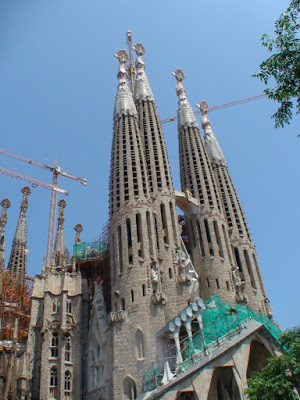
Gaudi segrada Familia Spires
Mention Gaudi, and everyone will instinctively think 'Barcelona' for his architectural work is synonymous with the city. His name has now morphed into the word gaudy, and is associated with that which is garish, outlandish and just plain 'out there'. Nothing quite prepares you for his kaleidoscopic cathedral, the Segrada Familia, even if you have seen it in photographs or movies. It is like one of those Bali paintings that you can look at one hundred times and then find something that you had not seen previously, on the hundred and first viewing. Its spires, with accompanying crane gantries, look like ancient, or futuristic, rocket ships awaiting launch codes. It was started in 1882 and the projected finish date is 2026, but don't hold your breath. And all his other works, which dot the city like cluster bombs, are just as mind-blowing, as avant garde today as they were when they were first introduced to Barca citizens and the rest of the world, for there is nothing quite like them on earth. Many of the outside designs look molten, like Dali's famous The Persistence of Memory, featuring molten clocks, rather than moulded or built, and their juxtaposition next to 'ordinary' buildings, merely highlights their continuing quirkiness.
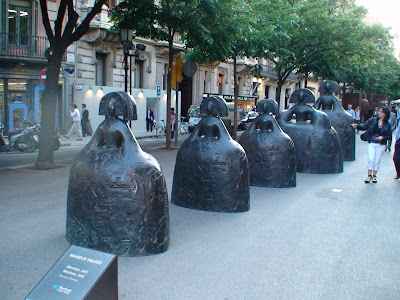
Barcelona Ladies of Spain
But while Gaudi did his own thing, he dragged others along as well, a bit like following a speeding driver on the basis of 'they'll crack down on him first'. And when 'they' didn't but gave Gaudi his head, every other architect sped along as well. There are wonderfully designed buildings of contrasting styles, often set back so that you can actually look at them, ornate or simple, the wide-spread use of wrought iron, stone and masonry, straight lines or angular, protruding, concave, convex, bright colours and dull, a gathering of standing objects as diverse as if you had one person from each country in the world, in a conga line. The Barcelona that we saw had put it all together beautifully, blending ages and substance wonderfully, as if at a large family gathering, on which outsiders look with a good degree of envy. I am sure that the Olympics did wonderful things for the image of Barcelona, for it is a place that both its citizens, and its visiting tourists, seem to enjoy thoroughly.
From Barcelona we flew to Malaga via Madrid, on a crowded but efficient Air Europe service. The days of empty, spread-out-able flights, really seem a thing of the past. The countryside below our wings looked thirsty, except for the azure blue swimming pools, which look like terrain smallpox, as we flew into and out of Madrid. The plots of land too, looked small and divided into squares and strips, a legacy, no doubt, of inheritance and sub-division due to too many sons and daughters over the centuries! The brown hues, and the remoteness of settlement as we flew across Andalusia, reminded us somewhat of Australia. Who knows, if those Spanish sailors had ventured south instead of west, they might have 'found' Australia, and found it to be agreeable, rather than those Dutch that wanted only green and verdant lands, and not finding it, pushed off. It would certainly have done wonders for our Spanish language!
We landed at Malaga and saw a few aircraft from the Middle East, for Arabs like the Costa del Sol, and the Saudi King has a vast acreage in Marbella, replete with mosque, and a fleet of Boeing 747's for re-victualing during 'the season' when so much of the Middle East moves to Spain. We headed further south, along the coast, on a good road, past condos that looked like temples to tack at Toresmolines, with hamburger haute cuisine advertisements by the roadside, and the Mediterranean a shimmering, inviting blue, to our left. To our right, there were bald and rugged hills, jacarandas and gum trees, and where the developers hadn't taken great swathes for condo and golf course development, (There are over 50 golf courses along this stretch of coast), there were still old white walled, orange roofed farm houses amid the olive and cork groves. Not that all is tacky, as there were some stunning jewels, discretely designed and unassuming, but it is the 'mass scale' that surprises, and you wonder where the people will come from to settle them all. Maybe the 'new wave' of wealthy Russians, Indians and Chinese will fill the spaces as the developers have certainly been going gang-busters to build. In some cases, whole developments have to be pulled down because of illegal building and the inability of administrators to meet the pace of change. Better then for the developer to declare bankruptcy and save the additional pull down costs. It is a big problem.
A lovely irony is that while sons often inherited coastal bits of farm land as farming was simply too difficult in the rugged mountain areas, the daughters were generally given the 'useless bits'. The coastal bits were sold years ago when the pace of development ran at a trickle. Now, however, there really is gold in them thar hills, and plots are worth squillions as 'get-away-from-it-all' private estates, with lofty views, are developed on golf courses. And they are still are only thirty minutes drive from the coast. We stayed with friends who had a magnificent eyrie, on which they had built a simply stunning mansion. We sat on one of their 'porches' and looked over a veritable polo field of lawn and an infinity pool to the cool Mediterranean, with the Pillars of Hercules as a backdrop. The green golf course swaggered beneath us, sculptured into the hillsides, and with not a soul on the fairways. The sky was azure blue above. It doesn't come much better. Even where there is high-density development, there are town houses and apartments, all painted white, which hug the hillside just like the traditional, centuries-old Andalusian 'white villages'. From a distance, little appears to have changed since the times of the Moors.
In the 1940’s, presumably with approval from uber-friend General Franco, Prince Max Hohenlohe-Langenberg was driving his Roller along the coastline at Marbella. Alas the said motor broke down, cursed English machine that it was. Well, with a war on, and the Roller factory rather desultory on car parts, especially to Fascist friendly countries, poor old Max had to stay put, and fortunately, he took a shine to Marbella. In the 1950’s, his son and heir, Prince Alphonso, thought that it would be a good place to build a pad and invite all their right royal friends, and all sorts of all-sorts, down for a dip and a dance. As old pal Franco was still in charge, it was merely a case of ‘Come on down’. So started the Marbella Club Hotel, and the city has been a celeb citadel ever since, full of casinos, bars and night-life, a sort of 'California (with lots of fawnia!) by the Med'. Arab royalty came by the plane-load, why even Osama bin Laden in his BC (before conflagration) days. Naturally the Hollywood set came too (Sir Sean Connery had a fall out with the authorities, and moved to the Bahamas; Joan Collins came too, but then she’s been with everyone and everywhere, so too Posh and Becks, Antonio Banderas and his siliconed wife, even Lady Di, although she had a different set). It became known as the ‘playground of the rich’, and it has seldom looked back since.
We made our first foray into Marbella for lunch, and sat in an old square in warm sunshine, shaded by big orange umbrellas, the fish and the wine all plucked from near-abouts, only a few minutes ago. All the buildings were white and while lots of them were small, most of them were stylish. You can sit around a meal, or a cup of coffee, for as long as you like, for no-one ever hassles you to leave. Why even the cops dawdled around as though time was a dirty four letter word. An old town bubbled all around us, well till the siesta hours, and then things went as quiet as a cat after a bowl of milk. Besides, Rafael Nadal was playing in the French Open, and any vertical Spaniards were soon seated and glued. We had the old town to ourselves, narrow alleys, shoe-shops with fortunately locked doors, a badly timed wedding in a huge cathedral, but then again, the service was in English, but even so, I did hear furtive whispers of “What is the score?”
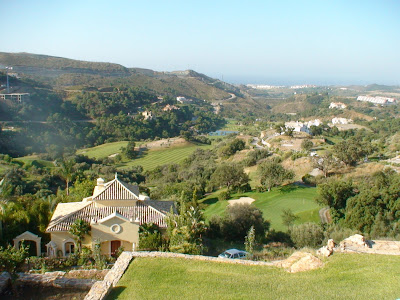
Marbella - Room for the View
We came back at night and went to Puerto Banus where sculptures by Dali adorn the streets and tell you, “This is expensive-ville”. The brand shops front a harbour carrying yachts bigger than those Caribbean cruise liners, the cars are all of the noblest pedigree, the restaurants are mostly plush and packed. And everywhere there are posies of the most perfect poppets, with legs that run all the way to Holy Toledo, and busts that smile at you like the Sphinx. We joined the ranks of gawkers, and took it all in, and later wandered down a back street where the pole dancers were at play, and the area was thrumming. We passed a stretched Hummer marked Gentleman’s Club, which was big enough to carry Ali Baba and the Forty Thieves, as well as a tent-full of temptresses. We eventually got back to the parking garage and paid our two hour’s parking fee, a fee akin to the deposit on a small house. In Marbella, they see you coming!
Our Dutch hosts took us to a marvellous “Herring Party” whereby the very well heeled Dutch expatriate community have the season's first fresh herrings, flown in from Holland, undoubtedly at great expense. It was held at the ‘Savoy of the Sol’, the beautiful Puento Romano Hotel, whose main feature was, naturally, an ancient Roman bridge, now set amid wonderful gardens that stretch all the way to the beach. The weather was just perfect as we milled in a courtyard spotted with trees and terraces. There was a profusion of hats and Fascinators, tweed jackets and cigars, lots of leg and as expected, a bevy of boobies. A jazz band played, the champagne flowed, and men and women held herrings by the tail, tilted back, and swallowed the lot. Now, I am a sometime Dutchman, but I let the side down badly by gagging on my herring while my wife swallowed hers with cool charm, but her champers followed a nano-second later. I did better on the eel, but thank goodness there was cheese and Dutch croquettes. It was a thoroughly enjoyable party, full of interesting, successful people who in the ‘Europe without borders’ have made the easy decision to come and live in Spain. Why, it has a great climate, ambience, sophistication, beaches, friendly Spaniards, good infrastructure, all two hours flight from anywhere in Europe. I imagine it was an easy decision to relocate, especially if made on a winter's day!
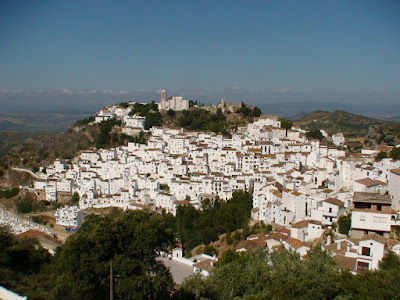
Andalucia - Cesares Village
The next day, while the women went shopping, the men drove into the hills to the old ‘white village’ of Cesares. The Romans had been here, Caesar himself, for he gave it its name, and in the ruined fort atop a pimple, there is a plaque that “Caesar walked here”. The village now, as then, tumbled like a waterfall down a mountainside, beauty in white and orange, cliffs above the plain, with a fort on top. Later the Moors took it, and held it, to defend against the onslaught of Christianity, but now their mosque is gone, and an old church (which has been awfully ‘modernized’) rests within the castle precincts. There are steep streets with tiny houses and great pots of flowers which adorn the white walls like a colourful Spanish moss. There are shops the size of a medium sized refrigerator and in the town square, by a monument to the fallen in the Civil War, the old men still meet and talk over a cigarette and a coffee. In reality, life appears to have changed little, and the vistas as well, except for a huge wind-farm on a nearby hillside, where two dozen slim-line windmills twirled. A wayward Don Quixote and Sancho Panza, far from La Mancha, would today merely shake their heads in puzzlement, before Don would say “Hand me the lance, Sancho”.
We travelled along magnificent roads past the industrial conglomeration that hugs the surrounds of Gibralter like a muddy boot, and then travelled to a windy point where we overlooked the famous straits, and beyond it, the misty mountains of Morocco and those little foot-prints that Spain still holds in Africa. Two large ships were butting through the wind swirled waters, and I thought of the many great fleets which had made the same journey. A little below us was the port of Tarifa, the most southerly point of Continental Europe, and supposedly the place that gave us the term 'tariffs' from the costs borne in entering its harbour. Beyond Tarifa's honey-combed town, and its great fort, a vast expanse of golden sandy beaches, where kite surfers bounced and flew, was the white capped Atlantic Ocean and the way to the New World. Columbus had sailed these waters, Nelson too. Now, illegal immigrants from Africa chanced their lives in making the crossing on dark and windy nights.
The following day, we climbed a serpent of a road till we stopped on a pine-capped ridge, and looked down towards Marbella and the Med. In the other direction, through forests of pine were the rugged ridges beyond, with tiny clusters of settlement white against the rocks, red poppies sometimes providing a vivid and unlikely splash of colour. Once, pine trees had stood from Gibraltar to the Pyrenees, but so much was cut down, to build houses, the Armada, or simply to burn when the winters were cold. Now much was barren, with great granite tors, which only served to highlight the isolation of villages and the dramatic nature of their settings.
We drove on to Ronda, one of the most dramatically sited towns in Spain, where the river through the 120 metre El Tajo canyon carved out a very narrow separation between two cliff tops. The separate towns have been occupied as fortified places, by Celts, Romans and Moors, before Catholic Spain claimed it in 1485. The Romans built an early bridge to cross the gorge, then the Moors built one on top of that, and in 1793, the 'new bridge' was built over the top, and that is the one that we still cross today. The vista of the farming lands, way below, is mesmerising, especially against the back-drop of sharks-tooth mountains that ring the city. Despite the large number of tourists that shared our vantage spots, there was also a certain serenity that the bridge evoked, quite belying its turbulent past when Nationalist sympathisers were merely the last in a long list of those, who through history, had been hurled onto the rocks below.
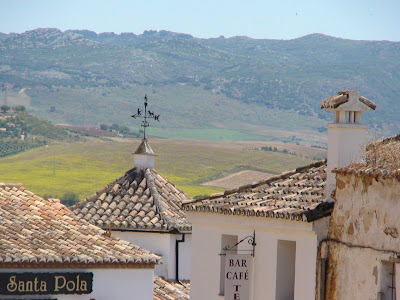
Ronda
Ronda also has the first Plaza de Toros bull-ring, in all of Spain, and my wife and I quickly posed in front of a bronzed statue of a caped crusader. We readily understood why people like Ernest Hemmingway and Orson Welles had chosen to live for a time in Ronda for it was an inspirational place. We found a restaurant in the old town, where the waitress was beautiful, but the service and food were lousy, and we sat there in the siesta hours and listened to the sound of the birds, the clip-clop of horse drawn carriages, and the ringing of bells telling us the time. Without the noise of cars, we could easily have turned back the centuries.
Our first visit to Spain was an awakening, with an instant longing to return again, long before our aircraft climbed out of Malaga and over the jumble of buildings below, before streaking out over the greeny-blue Mediterranean. Like so many Europeans, the Spanish take their history for granted, as well as the natural beauty of their country, yet in the parts that we saw, they do so easily, at a relaxing pace, and with a willingness to share. There is still so much of Europe that we want to see, and give the 'once over', but Spain, well, it will definitely get a second look!
